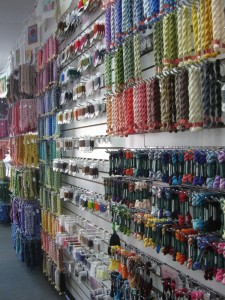
The question of whether you can return threads and how stores will take them back is one that frustrates and confuses many stitchers. This article looks at the different policies often found, what threads need to be, and why stores have the policies they do.
Return Policies
Most shops have one of two policies for returns. Either they do not accept returns on thread or they accept returns for a limited time and with receipts.
While this protects the store from unscrupulous returns, it also encourages you to choose wisely when buying threads.
The Reasons for the Policy
When I asked shopowners recently about the reasons for their policies, I got tons of stories that, quite frankly, surprised me.
The policy requiring receipts keeps folks from returning threads bought elsewhere. You’d be surprised how often folks try to return threads not even carried by the shop. It’s unjust to ask a shop to take back merchandise they did not sell.
The limit on time for returns is one shops of all kinds put into place to keep them from having to accept years-old merchandise just because you don’t want it. For threads think about the changes that may have happened: the label can have changed, the color or thread could be discontinued, the thread may be made by a different company. All these things affect whether a thread can be resold as new.
The folks at Thistle Needleworks in Connecticut told me about someone who accumulated years of threads and the tried to return them all at once! Cleaning up your stash is great — but why not resell your threads through a consignor or donate them to your guild auction?
Marion Scoular told me about a person returning the threads who had used some of the thread and then returned it. If this sounds to you like wearing the dress and returning it, it’s actually far worse. The dress can be cleaned, retagged, and sold. The thread cannot. The new owner only finds out when there is not enough thread in the package.
At knitting shops they also have a no return policy. For them a big reason is dyelots. Yarn comes packaged with a dozen skeins per package. If you buy 8 skeins for a sweater and return one, the shop is left with a skein that probably will not match the next dyelot. There are not tons of uses for that odd skein.
The same holds true for our threads. One skein of a bright color might be used, but what if it’s a good background color? Or what if it is used extensively on your canvas? That odd skein can cause lots of problems!
Thread Condition
To be returned thread must be:
- unopened (and uncut)
- able to be restocked and sold
- have tags still on
A thread that does not meet these criteria is useless to the shop. You are better off putting it into your own stash for future use.
I keep my threads instead of returning them, even if they are in new condition. I buy thread for my stash. I realized long ago that it’s a rare canvas that uses all of a package of thread. By not returning unused thread, I have that “just a bit” of a color I need to finish a project. I didn’t have to buy new, I didn’t have to return the thread, and I could stitch on my schedule instead of the store’s.
I also find that it increases both my knowledge of threads and my creativity. Because I have invested in those threads, I want to use them. But I also need to work to find the threads that work on my canvas. I have done this for so long, that I can’t work any other way. Try it, you”ll love it too!
About Janet M Perry
Janet Perry is the Internet's leading authority on needlepoint. She designs, teaches and writes, getting raves from her fans for her innovative techniques, extensive knowledge and generous teaching style. A leading writer of stitch guides, she blogs here and lives on an island in the northeast corner of the SF Bay with her family

Leave a Reply